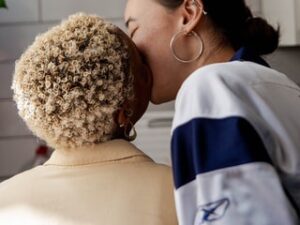LISTEN: This rock & roller was ‘Rockin’ the Joint’ (& a pompadour) long before Little Richard


No one would blame you for mistaking Rock and Roll pioneer Steven Quincy “Esquerita” Reeder Jr. (a.k.a. Esquerita) for legend Little Richard. They both hail from the South, Esquerita of South Carolina and Little Richard of Georgia, and they both were known for their exuberant piano skills, pompadours, and love for rock and roll. But while Esquerita taught Little Richard the piano and style that made him a star, he saw his own career fade into the cosmos.
Born in Greenville, South Carolina, in 1935, Reeder honed his voice at his church, similarly to Richard, and took up singing and playing piano at the local Tabernacle Baptist Church where his mother was choir director. As a teenager, he jumped at any chance to perform and dropped out of high school to travel with the NYC-based gospel group, the Heavenly Echoes, even appearing on their single “Didn’t It Rain” (in 1955).
After the Heavenly Echoes broke up, Esquerita began to hone his solo act, playing in clubs across the country from New York City to New Orleans before establishing himself as the resident rock and roller of the Owl Club in South Carolina. He performed under the moniker “Professor Eskew Reeder” and developed a manic, showy style of piano playing, and he complemented this style with a look that included heavy makeup and sky-high hair.
On paper and in persona, Esquerita was seemingly Little Richard before there was a Little Richard, and his stage presence led to him being discovered by Blue Caps group member Gene Vincent and later signed to Capitol Records. Somewhere along the way, Esquerita actually had an encounter with Little Richard, and it was this meeting that forever changed the trajectory of both their careers.
As Richard recounted in an interview clip, both performers seemed to be equally inspired by each other. “I met him at the bus station. One night I couldn’t sleep in my hometown. I would sit there all night and watch people get off the bus … you understand. And he got off,” Richard said of Esquerita. “And I said, oh boy!”
Richard credits Esquerita as his primary piano influence, saying, “He was one of the greatest pianists, and that’s including Jerry Lee Lewis, Stevie Wonder or anybody I’ve ever heard.” In his signature hyperbole, Richard also shared about Esquerita, “He had the biggest hands of anybody I’d ever seen. His hands was about the size of two of my hands put together.”
By the time Esquerita began to find his footing with popular songs such as “Hey Miss Lucy” and “Rockin’ the Joint” in 1959, Little Richard had already blasted off with his mega-hit “Tutti Frutti” in 1955 and became a Black, queer icon. Capitol Records released Esquerita’s only full album, “Esquerita,” in 1959, but Esquerita’s career began to be swallowed up by Richards’ increasingly larger-than-life persona.
Throughout the ’60s, he recorded with musicians such as Jimi Hendrix, Dr. John, Allen Toussaint, and The Jordanaires (Elvis Presley’s backup singers) before he went through another evolution and changed his name to Magnificent Malochi and signed with Brunswick Records. Under Brunswick in 1968, Esquerita co-wrote Little Richard’s adaptation of Bessie Smith’s 1936 “I got what it takes,” and it became “Stingy Jenny (Got what it takes but it breaks my heart to give it away).”
Although he did not share in the solo success Little Richard had, Esquerita had steady work writing songs for Little Richard, Linda Hopkins and playing backup keyboards on hits such as John Hammond’s “Takin’ Care of Business” before forming a group with crop of New York City-based musicians in the early 1970s. It was also then that Esquerita reportedly performed at gay clubs under the drag name Fabulash, according to the book “Incredibly Strange Music,” and continued to perform at minor clubs.
By 1983, Esquerita was tracked down by writer Billy Miller for an interview in issue #3 in Kicks Magazine. The story behind this interview was detailed by Baynard Woods for Oxford American. Gone was the sheen that made him a star but he still had the piano skills and was reportedly working as a parking lot attendant in between occasional performing gigs.
Three years later, Esquerita would die from AIDS complications at a hospital in Harlem. But despite his tragic turn of fortunes, Esquerita is considered an icon in many rock and roll circles, and he knew it. About Little Richard, he said “When I met (Little) Richard, he wasn’t using the ‘”‘obbligato’ voice. Just straight singing,” which seemed to acknowledge the influence he had on adding to Richard’s persona. Although some say they were equally influenced by each other, it is surely true that there would be no one without the other.
Listen to Esquerita’s “Rockin’ the Joint” and tell us who you think was the real queer king of rock and roll?




